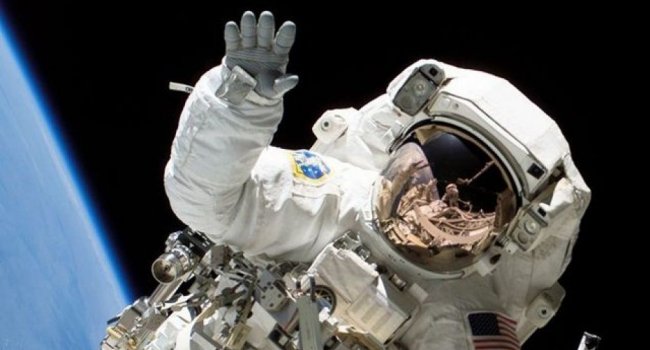Jaws dropped as Japanese astronaut Norishige Kanai announced on Twitter Monday that he had grown 3.5 inches in the span of just three weeks while aboard the International Space Station (ISS).
“Today I share some serious news. Since coming to space, I have grown 9 centimeters. This is the most I’ve grown in three weeks since junior high school. I am a little worried I won’t fit in my seat on the return trip on Soyuz,” Kanai tweeted, referring to the Russian Soyuz TMA spacecraft that transports crews to and from the ISS.
A day later, Kanai apologized for spreading “fake news,” clarifying that he miscalculated the measurement. He had actually grown 0.9 inches – 2.6 inches less than he initially claimed.
“This mis-measurement appears to have become a big deal, so I must apologize,” the 41-year-old astronaut posted on Tuesday, without elaborating. “It appears I can fit on Soyuz, so I’m relieved.”
Kanai’s initial statistic seemed staggering, but it’s actually not that uncommon for astronauts to experience rapid growth spurts during their first weeks away from Earth.
In fact, when it comes to time spent away from gravity, a slight height boost is just the tip of the iceberg. Here are five ways space can change the human body.
Can astronauts grow taller in space?
Astronauts can grow up to 3 percent taller while traveling in space, NASA scientists say. That’s because there is less gravity pushing down on vertebrae in the spine. As a result, the vertebrae expands and relaxes, allowing the body to stretch up to 2 inches.
The majority of growth occurs as soon as a spacecraft goes into orbit, according to NASA. Astronauts continue to experience gradual change over time, but the relaxation of the spine eventually comes to a halt.
If astronauts stayed in space forever, they would not continue to grow and grow, Dr. Sudhakar Rajulu, a technical manager at NASA, explained in a statement online.
In fact, the growth is only temporary.
Astronauts’ spines return to normal curvature as soon as they return to Earth. They’re typically back to their pre-flight height within 10 days.
NASA astronaut Scott Kelly was about 2 inches taller when he returned to Earth after a 340-day stint on the ISS in March 2016. However, as predicted, Kelly’s height gain was only temporary. The astronaut’s twin brother – and former astronaut – Mark Kelly told CNN that his brother took less than two days to return to his normal height.
What happens to the bones of astronauts?
It’s common for astronauts to gradually lose muscle strength and bone density while on long-duration spaceflights. Studies of astronauts who spent several months on Mir, a space station that operated in low Earth orbit from 1986 to 2001, revealed that space explorers can lose, on average, 1 to 2 percent of bone mass per month.
“The magnitude of this [effect] has led NASA to consider bone loss an inherent risk of extended space flights,” Dr. Jay Shapiro, team leader for bone studies at the National Space Biomedical Research Institute, said in an online statement.
Weightlessness is likely the cause of bone loss in space.
When living in a gravity-free zone, bones no longer have to fight against Earth’s gravity to provide support for locomotion or for maintaining body posture, NASA explains. Therefore, there is little mechanical strain on the body, resulting in progressive bone loss.
The International Space Station sits at an altitude of approximately 220 miles above the Earth in this photo taken by Expedition 27 crew member Paolo Nespoli from the Soyuz TMA-20 following its undocking.
Are astronauts’ eyes being affected by space?
It’s true: More than half of American astronauts have experienced vision changes and alterations to parts of their eyes during and after long-duration flights.
NASA researchers believe the headward fluid shift that occurs during flights leads to increased pressure on the brain, which may push on the back of the eye, causing it to change shape.
In 2015, a group of NASA scientists partnered with the Russian Space Agency (Roscosmos) to study the impact these shifts have on vision and eye structures. The groups expect to conclude part of their research in February.
Why do astronauts get puffy faces in space?
Astronauts may feel perfectly healthy when they launch into space, but that feeling won’t last. When astronauts first travel into space, they feel as if they have a cold, and their faces start to look puffy.
That’s because the fluid in their bodies redistributes, spreading equally throughout the body, as they move to microgravity environment.
The body records this shift as an increase in blood volume, NASA said. It then adjusts by eliminating what it thinks are extra fluids through the kidneys. Once the fluid is flushed from the body, astronauts adapt to the new distribution of fluids and begin to feel (and look) normal again.
Do astronauts sleep well in space?
The short answer: no.
Sleep deprivation is a common complaint among astronauts. Research has shown that astronauts tend to sleep an average of six hours per night.
Changes in biological clocks or circadian rhythms contribute to sleep deficiency. And the fact that astronauts experience a sunrise or sunset every 45 minutes as they circle Earth in orbit certainly doesn’t help.
“Rapid schedule changes are a problem, but so is exposure to light at times when the astronauts are scheduled to sleep,” Erin Flynn-Evans, a researcher at the Fatigue Countermeasures Laboratory at Ames, described in a 2016 interview. “The crewmembers will often look out the cupola window to get a view of Earth during their scheduled sleep time, which can expose them to a bright blast of sunlight and inhibit their ability to sleep.”












